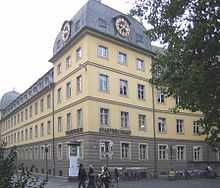German Bestelmeyer (8 June 1874, Nuremberg, Bavaria – 30 June 1942) was a German architect, university lecturer, and proponent of Nazi architecture.
Life
From 1893 to 1897 Bestelmeyer studied architecture at the Technical University of Munich, where he was a student of Friedrich von Thiersch.
During the Third Reich mere opposition to Bauhaus architecture was enough to gain official approval for almost any architect, as with Bestelmeyer. A member of the Munich School to which Paul Troost also belonged, he had been trained under Theodor Fischer. He was praised by Paul Schultze-Naumburg in a lecture in 1931, because he aligned himself with supporters of traditional styles. In 1934, he became head of the Munich Academy of Art to which he enlisted Alexander von Senger, the passionate opponent of Bolshevik architecture. Later, Bestelmeyer designed the Luftwaffe office building on the Prinzregentenstraße in Munich. This traditional building and his other works were singled out for praise in the later 1930s. An article he wrote in 1934 sums up his ideas and probably drew the approval of Nazis. Admiring Senger's criticism of Le Corbusier, he found that, in the 1920s architecture was petrifying into mere architectural technology, creating soulless buildings. The flat roof, he said was simply not practical for Germany's climate. His 1928 alliance with Schultze-Naumburg, Schmittehenner and others into "The Block", a group of architects determined to combat the experiment of the Bauhaus, made him acceptable.
Works (selected)

Altes Stadthaus in Bonn
| Persondata |
|---|
| Name |
Bestelmeyer, German |
| Alternative names |
|
| Short description |
German architect |
| Date of birth |
8 June 1874 |
| Place of birth |
Nuremberg |
| Date of death |
30 June 1942 |
| Place of death |
Bad Wiessee |
